“Violence is the way stupid people try to level the playing field.”—John Gregory Dunne
Over the many years that people have been encountering seemingly paranormal creatures, more than a few of them have been armed and decided to take a shot at the unknown critter. Since we still don’t have any dead bodies of any cryptids or apparent aliens, you can probably guess how well this has worked out. What follows here are some of my favorite instances of the futility of trying to fend off the supernatural with bullets.
One of the earliest documented incidents of this sort of thing happened in Robertson County, Tennessee in 1817. A farmer named John Bell saw an unusual creature in his corn field. He said that it had the body of a dog but the head of a rabbit (what I like to call a Tennessee esquilax). This being the early 1800s, he naturally had his musket with him in case any Native Americans dropped by to demonstrate their displeasure with his turning their former hunting ground into a farm. He must not have liked the looks of this thing, because he decided to take a shot at it. By some accounts, he hit  it, although other sources are less clear about that. In any case, it doesn’t seem to have mattered. The creature responded by vanishing before his eyes. One might simply dismiss this as a case of hallucination if not for the fact that this was but the first of many bizarre events that would plague the Bell family over the next several years in what would come to known as the infamous Bell Witch poltergeist haunting. These events would be witnessed by dozens of people, including no less than future president Andrew Jackson, who heard about the case while he was in the area and decided to have a look for himself. He didn’t stay long.
it, although other sources are less clear about that. In any case, it doesn’t seem to have mattered. The creature responded by vanishing before his eyes. One might simply dismiss this as a case of hallucination if not for the fact that this was but the first of many bizarre events that would plague the Bell family over the next several years in what would come to known as the infamous Bell Witch poltergeist haunting. These events would be witnessed by dozens of people, including no less than future president Andrew Jackson, who heard about the case while he was in the area and decided to have a look for himself. He didn’t stay long.
One of the most unusual cases of shooting a paranormal beastie occurred on the Sherman Ranch (aka Skinwalker Ranch). It involved a very large and seemingly tame wolf that Mr. Sherman only fired on when it attacked one of his calves and hitting it with blunt objects had no effect. The events that led up to this are too involved for me to go into detail (and if you haven’t read The Hunt for the Skinwalker, you really should), but just the events of the shooting are compelling enough on their own.
As the wolf had its jaws clamped down on the head of the calf, Tom Sherman fired three rounds form his .357 Magnum into its side from 10 feet away. There was no blood, and the first two shots had no effect at all. Only after the third shot did the creature release the calf and then turned calmly to stare at Sherman with its blue eyes. He fired again at the front of its chest where its heart should be. The only effect was that the wolf began to slowly back away. Tom then instructed his son to get his rifle from the house. By the time he took aim and fired, the wolf was 40 feet away, but this was still practically point blank range for the man who had used this rifle to drop elk from 200 yards. The first shot was as ineffective as the ones from the handgun. The second shot went right through the animal, and the family saw a chunk of flesh fly off the back of it from the exit wound. Only then did it turn casually away from them and begin to trot off as if nothing had happened.
Tom Sherman and his son took off after it, but it was putting distance between itself and them. They chased it for about a mile before they came to a creek. The wolf’s prints were clearly visible in the mud, but this was where the chase ended. There were tracks in the soft ground for a few feet, and then they just stopped. There was no more wolf and no more tracks. It was as if it had just vanished into another dimension – perhaps one in which wolves are big and friendly and bullets don’t bother them. Only a few minutes earlier, the whole family had been petting this creature.
If you’re familiar with Skinwalker Ranch, then you know that unusual animals were far from being the only form of weirdness going on in the area at the time. Like Point Pleasant, West Virginia in 1967, it was a virtual paranormal funhouse with UFOs, poltergeist activity, cattle mutilations and more. Another region where these sorts of things were going on just a few years ago is a place called Marley Woods in Missouri. It’s an area in Oregon County in the southern part of the state and where, in 2008, a rancher spotted a pair of what appeared to be huge, white dogs traipsing through one of his fields. From his vantage point about 800 feet away, they looked to be about 200 pounds and therefore large enough to pose a threat to his livestock, so he took out his rifle and shot one of them. The creature never even broke its stride despite the fact that the rancher said that a portion of it “turned red.” They trotted on until they were out of sight, but multiple people reported seeing one or both of them in the area over the next several months, although none reported seeing any bloody fur and no blood was found at the site of the shooting. Some long, white hairs were recovered from a barb on a fence and sent to a lab for identification. So far, no match to any known animal has been found, and there are no large, white animals indigenous to the region.
 Three years earlier in 2005, it was the heyday of Chubacabra in Puerto Rico, and paranormal investigator Nick Redfern was there looking into the matter. The standard description of the creature is that it looks basically humanoid but seriously ugly with spikes on its back and big, red, glowing eyes. What it generally leaves behind are dead farm animals with two puncture marks on their necks that have been completely drained of blood. (Chupacabra means “goat sucker,” as in “That damn thing sucked all of the blood out of my goat!”)
Three years earlier in 2005, it was the heyday of Chubacabra in Puerto Rico, and paranormal investigator Nick Redfern was there looking into the matter. The standard description of the creature is that it looks basically humanoid but seriously ugly with spikes on its back and big, red, glowing eyes. What it generally leaves behind are dead farm animals with two puncture marks on their necks that have been completely drained of blood. (Chupacabra means “goat sucker,” as in “That damn thing sucked all of the blood out of my goat!”)
While he was there, he met a farmer who told him about the night that he lost a pig and several rabbits to the creature. While the carnage was going on, the rest of the animals were raising such a commotion that it woke the man up and he ran outside with a machete. It was too dark for him to see what the predator was, but he was able to make out a large shape and hurled the machete at it. To his surprise, he heard a sound like the blade bouncing off of metal plating. At least that was enough to scare it off. Upon examining the carcass the following morning, he found that the pig had three rather than the usual two puncture wounds on its throat, so this would appear to have been the work of one of the rare armor-plated three-fanged Chupacabras.
Okay, throwing a machete at something doesn’t qualify as shooting at it, but the sound of metal hitting metal in this instance has some interesting parallels with at least two other cases, so I thought it was worth mentioning.
Spring-heeled Jack was a humanoid who primarily accosted young women, usually in the greater London area, off and on beginning in 1837 and possibly continuing all the way up to 1920. Early victims described him as being a hideous man in a long cape and top hat. He later reinvented himself by wearing a superhero-esque bodysuit with a bat wing cloak and helmet. What never changed was that he mostly liked to spring upon unsuspecting girls and fondle them with metal claws on his fingertips. He got his name from his ability to make impossibly high leaps over high walls and fences or up onto rooftops, some instances of which were seen by multiple witnesses in clear daylight. He also occasionally breathed a blue, plasma-like substance from his mouth into the faces of his victims. This left them either unconscious or severely disoriented.
During the 1870s, Jack ventured outside of London and put in a number of appearances at two different military bases. Naturally, the men there were armed and fired at him on at least two occasions. As you can probably guess at this point, the shots had no effect, but the soldiers reported that when their bullets struck him that it made a sound like bullets hitting sheet metal. That sounds vaguely familiar.
Fast forward to rural Kentucky in the 1950s and what has come to be known as the case of the Hopkinsville Goblins.
People shooting at unknown entities isn’t just relegated to the files of cryptids or mysterious, fire-breathing men in melodramatic costumes. At least in one instance, the participants fired repeatedly at apparent space aliens over a period of hours. It is, as far as I can determine, the longest lasting and most investigated case of people shooting at the unknown on record. Even the military got involved in this one.
There were 11 people in the Sutton home on their farm near the little town of Kelly, Kentucky on the night of August 21, 1955. One of their guests, Billy Ray Taylor, told everyone that he had seen a flying saucer come down from the sky and that it appeared to have landed behind a ridge near the edge of the property. No one believed him.
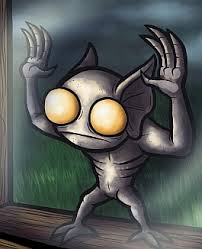 About an hour later, the family dog began barking, and Taylor and Elmer Sutton went outside armed with a 20 gauge shotgun and a .22 caliber rifle to see what was going on. What they saw was a small, glowing creature with long arms, a large head, big yellow eyes and huge, pointed ears walking toward the house. Even though it had its arms raised above its head, they began shooting. However, instead of falling down dead like a reasonable person would, the creature did a backflip and then scurried off into the woods. But he would be back…again and again, and usually with a friend.
About an hour later, the family dog began barking, and Taylor and Elmer Sutton went outside armed with a 20 gauge shotgun and a .22 caliber rifle to see what was going on. What they saw was a small, glowing creature with long arms, a large head, big yellow eyes and huge, pointed ears walking toward the house. Even though it had its arms raised above its head, they began shooting. However, instead of falling down dead like a reasonable person would, the creature did a backflip and then scurried off into the woods. But he would be back…again and again, and usually with a friend.
To make a long story short, the shooting continued for the rest of the night and didn’t end until shortly before dawn. The usual scenario was that the “aliens” would peer into the house through a window and the men would shoot at it until it ran off. One exception was when they shot one of them out of a tree. It then floated gently down to the ground before running away. By the time it was all over, the house was completely shot up and nearly every window blown out.
More than 20 state and local law enforcement officers and at least two members of the military investigated the case but found no evidence to confirm the tale other than the seriously damaged house. One final note of interest: the witnesses all claimed that when the beings were struck that it sounded like bullets hitting a metal bucket. Where have I heard that before?
But shooting at actual alien beings isn’t the only way that we’ve made our “guests” feel unwelcome. In 1980, Peruvian fighter pilot Oscar Santa Maria Huerta fired an estimated 60 rounds from his 30mm cannon into a spherical object approximately 30 feet in diameter as it hovered near the La Joya Air Base at Arequipa, Peru. By the pilot’s own account, the object “absorbed” the bullets without sustaining any apparent damage. He then spent the next 20 minutes chasing the object around the sky but never again managed to get off another shot at it. Every time that he got it in his sights and was about to fire, the object would suddenly dart out of the way as if it knew what was about to happen.
I seriously doubt that this is the only time that a military aircraft has fired on a UFO, but it’s the only case that I’m aware of where the pilot has confirmed the details of the event to the media and the U.S. Department of Defense. This public confirmation took place in 2013 at the Citizen Hearing on Disclosure held at the National Press Club in Washington, DC where Huerta told his story in person.
It probably won’t come as any surprise to most of you that there have been numerous reports of people shooting at BHMs (big hairy monsters, aka Sasquatch or Bigfoot), and some say that they are sure that they hit it, although we obviously have no dead bodies or even blood samples to confirm this. Perhaps the most well-documented case happened in rural Franklin County, Missouri in 1969. A man named Arbie Boyer called the local police shortly after 2:00 am to report that he had pumped nine .22 caliber bullets into the chest of a seven foot BHM that was standing just 20 feet outside of his front door. Unphased, the creature turned and began to walk away. Rather than just being relieved that it didn’t beat the crap out of him for shooting it, Boyer went back into his house and got his .45 caliber rifle. He got off a single shot into the creature’s right shoulder area before it disappeared into the trees. About a dozen officers spent two hours searching the woods but found no trace of it.
Fortunately, in my opinion, not everyone who has been armed at the time of their strange encounter has felt compelled to fire their weapon. Bob Gimlin, of the famous Patterson-Gimlin Bigfoot film, later said that he wished that he had shot the beast so that they would’ve had proof that they  weren’t lying. He did have a rifle, and while Roger Patterson was busy filming, Gimlin rode his horse across the creek bed to give himself a better shot, dismounted, took out the rifle and took aim in case the creature turned and advanced on them. Since it didn’t, he held his fire. As we’ve seen, it probably wouldn’t have mattered. He most likely could have fired away and it wouldn’t have made any difference, except that she might have turned around and flipped him off, which would have been hilarious.
weren’t lying. He did have a rifle, and while Roger Patterson was busy filming, Gimlin rode his horse across the creek bed to give himself a better shot, dismounted, took out the rifle and took aim in case the creature turned and advanced on them. Since it didn’t, he held his fire. As we’ve seen, it probably wouldn’t have mattered. He most likely could have fired away and it wouldn’t have made any difference, except that she might have turned around and flipped him off, which would have been hilarious.
Another guy who didn’t pull the trigger was hunting guide Don Young. He claims to have seen the Michigan Dogman five times, once in southern Wisconsin as it was crossing a dirt road deep in the woods and he happened to have his rifle in hand. He took aim at it but decided not to shoot since he was afraid that it might be a man in a costume and he didn’t want to commit murder. And not that I condone this sort of behavior, but it might have been interesting to know what would have happened if he had taken the shot. As far as I know, no one has ever shot a Dogman before. I wonder if it would have sounded like shooting a metal bucket, but I doubt it. That doesn’t seem to happen with the hairy ones.
Perhaps a better method of dealing with unknown beasties is the approach taken by Linda Bradshaw when she and her family began finding large footprints near the house on their ranch outside of Sedona, Arizona. Instead of shooting at it, she started leaving out plates of fruit overnight which she claims to have found eaten the next morning. There’s no way of knowing for sure if this made the BHM feel more kindly disposed toward them (or even if it was the one eating the fruit), but it at least seems to have befriended one of their horses.
They had a pregnant mare at the time which they were keeping in a separate pin from the rest of the herd. On several occasions, they found these large footprints inside of her pin. Unlike some other cases in which animals react with fear to unusual visitors, the mare appeared not to mind at all. Bradshaw grew up around horses and said that it’s easy to spot the telltale signs of a frightened animal in a pin. When they get scared, their instinct is to run. But when they’re in an enclosure, there’s nowhere to go, so they run in circles and leave a distinctive pattern of frenzied hoofprints. Bradshaw claims that she never saw any indication of this on the mornings when they found the giant prints in her pin, which clearly indicates that her horse had no fear of this creature whatsoever. Maybe we should take our cue from her.
Those three or four of you who are regular visitors to this site might have noticed that I’ve made several references in the past to using a rubber chicken and/or a dog whistle to rid yourself of unwanted monsters. The rubber chicken thing is just part of my shtick, but the dog whistle might actually work. In The Eighth Tower, John Keel mentions that UFOs and monsters alike tend to flee from loud noises like approaching sirens. He further stated that you can clear the skies of UFOs with one good blast from a bugle. I’m not sure how he knew that unless he actually tried it, but if it’s true, I can’t help but wonder how they would respond to something of so high a frequency that humans can’t even hear it. I carry one with me at all times just in case I ever get the chance to find out.
 Finally, I know that it greatly annoys many cryptozoologists and extraterrestrialists when I imply that these entities are anything other than flesh and blood beings. Nevertheless, I maintain that there’s just something not quite “normal” about them…at least in the sense of their being normal animals or normal beings from another planet. How else do you explain their stubborn refusal to be harmed by deadly weapons?
Finally, I know that it greatly annoys many cryptozoologists and extraterrestrialists when I imply that these entities are anything other than flesh and blood beings. Nevertheless, I maintain that there’s just something not quite “normal” about them…at least in the sense of their being normal animals or normal beings from another planet. How else do you explain their stubborn refusal to be harmed by deadly weapons?
In any case, the bottom line is this: Please don’t shoot the weirdos. It doesn’t do any good, and you just end up looking foolish in the process.


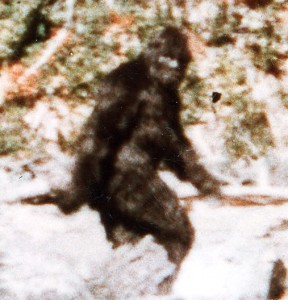 In 2004, nearly 40 years after the Patterson-Gomlin film was shot, a man named Bob Heironimus, also a resident of Yakima, Washington and a casual acquaintance of both Roger Patterson and Bob Gimlin, stepped into the spotlight by claiming that he was the one wearing the gorilla suit in the famous video. (Actually, a number of people have obtained a short-lived measure of notoriety over the years by claiming that they were the one in the suit, but none of them could come up with an even mildly convincing story as to how that had come about. At least Heironimus could verify that he knew Patterson and Gimlin.) He originally claimed that the suit had been made from the hide of a horse that Patterson had killed for the sole purpose of making a costume out of it. He later changed his story and said that it had been made by John Chambers, the costume designer for the original Planet of the Apes movies.* It would seem that at this point he hadn’t heard the claim made by Philip Morris of North Carolina’s Morris Costumes in which he stated that he had sold a gorilla costume that he made to Patterson in 1967. That would change, and the two of them would later team up to affirm that Heironimus had worn the custom gorilla costume that Morris had created. Unfortunately for them, they have never been able to get their stories straight, and the resulting inconsistencies leave a hole in their allegations big enough for the Loch Ness Monster to swim through. In fact, one Bigfoot enthusiast that I’m aware of has refuted Heironimus to within an inch of his life. He really doesn’t like that guy.
In 2004, nearly 40 years after the Patterson-Gomlin film was shot, a man named Bob Heironimus, also a resident of Yakima, Washington and a casual acquaintance of both Roger Patterson and Bob Gimlin, stepped into the spotlight by claiming that he was the one wearing the gorilla suit in the famous video. (Actually, a number of people have obtained a short-lived measure of notoriety over the years by claiming that they were the one in the suit, but none of them could come up with an even mildly convincing story as to how that had come about. At least Heironimus could verify that he knew Patterson and Gimlin.) He originally claimed that the suit had been made from the hide of a horse that Patterson had killed for the sole purpose of making a costume out of it. He later changed his story and said that it had been made by John Chambers, the costume designer for the original Planet of the Apes movies.* It would seem that at this point he hadn’t heard the claim made by Philip Morris of North Carolina’s Morris Costumes in which he stated that he had sold a gorilla costume that he made to Patterson in 1967. That would change, and the two of them would later team up to affirm that Heironimus had worn the custom gorilla costume that Morris had created. Unfortunately for them, they have never been able to get their stories straight, and the resulting inconsistencies leave a hole in their allegations big enough for the Loch Ness Monster to swim through. In fact, one Bigfoot enthusiast that I’m aware of has refuted Heironimus to within an inch of his life. He really doesn’t like that guy.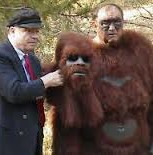 For some reason, Morris then made a much more elaborate costume that resembled the creature in the film and said that it was a re-creation of the costume that he had sold to Patterson, despite his original claim that he had sold him a simple gorilla suit. He had also earlier claimed that Patterson had phoned him to ask how to make certain modifications to the outfit to make it a more convincing fraud. Patterson would likely have had no need to make alterations if this later costume was an accurate reproduction of the first.
For some reason, Morris then made a much more elaborate costume that resembled the creature in the film and said that it was a re-creation of the costume that he had sold to Patterson, despite his original claim that he had sold him a simple gorilla suit. He had also earlier claimed that Patterson had phoned him to ask how to make certain modifications to the outfit to make it a more convincing fraud. Patterson would likely have had no need to make alterations if this later costume was an accurate reproduction of the first.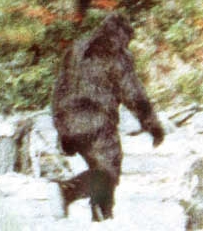 demonstrating his Bigfoot walk both with and without the new and improved costume. He’s got the arm swing, the head turn, and even the long stride down pat, but his back foot barely comes off the ground. If he was the one in the film, one might think that he would have remembered walking in such an unusual manner. In fact, he’s never even mentioned this, in all likelihood because that wasn’t him. None of this proves that the creature wasn’t a man in a costume, but it does make it seem unlikely that these two jokers had anything to do with it. So if not them, then who? No one credible has ever stepped forward to answer that question.
demonstrating his Bigfoot walk both with and without the new and improved costume. He’s got the arm swing, the head turn, and even the long stride down pat, but his back foot barely comes off the ground. If he was the one in the film, one might think that he would have remembered walking in such an unusual manner. In fact, he’s never even mentioned this, in all likelihood because that wasn’t him. None of this proves that the creature wasn’t a man in a costume, but it does make it seem unlikely that these two jokers had anything to do with it. So if not them, then who? No one credible has ever stepped forward to answer that question.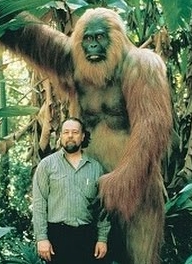 if you align the location of the knees with those of a same sized human, then the location of the hips and shoulders are off. Likewise, if you match up the location of the hips or shoulders, then the location of the other joints don’t match up. He concluded that the creature in the film has much longer upper legs and shorter lower legs than a human based on the location of the hip and knee joints. Also, its torso and arms are longer, and its hips lower than those of a human. Bottom line: if this was a man in a suit, he is one weird looking dude. And based on the findings of several independent analyses, the creature in the film is at least 6’ 6” and probably closer to 7’ 6” tall. So far, no human resembling such a tall and oddly proportioned individual has been located. Also, he would probably have a really weird walk.
if you align the location of the knees with those of a same sized human, then the location of the hips and shoulders are off. Likewise, if you match up the location of the hips or shoulders, then the location of the other joints don’t match up. He concluded that the creature in the film has much longer upper legs and shorter lower legs than a human based on the location of the hip and knee joints. Also, its torso and arms are longer, and its hips lower than those of a human. Bottom line: if this was a man in a suit, he is one weird looking dude. And based on the findings of several independent analyses, the creature in the film is at least 6’ 6” and probably closer to 7’ 6” tall. So far, no human resembling such a tall and oddly proportioned individual has been located. Also, he would probably have a really weird walk.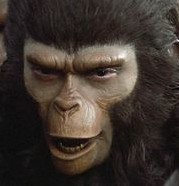 *There are still a few who maintain that Chambers did create the costume in the film, despite the fact that he said in a 1997 interview that he had nothing to do with it. He also admitted that he had never previously denied (and had probably encouraged) rumors that he had created it because he said that it was better than any costume that he was capable of making, but he enjoyed people thinking that he had. For three decades, it was a widely held belief in the Hollywood special effects community that Chambers was the man behind the Patterson-Gimlin film. Some still reject his 1997 confession and cling doggedly to the belief that Chambers was the one responsible for the hoax.
*There are still a few who maintain that Chambers did create the costume in the film, despite the fact that he said in a 1997 interview that he had nothing to do with it. He also admitted that he had never previously denied (and had probably encouraged) rumors that he had created it because he said that it was better than any costume that he was capable of making, but he enjoyed people thinking that he had. For three decades, it was a widely held belief in the Hollywood special effects community that Chambers was the man behind the Patterson-Gimlin film. Some still reject his 1997 confession and cling doggedly to the belief that Chambers was the one responsible for the hoax.